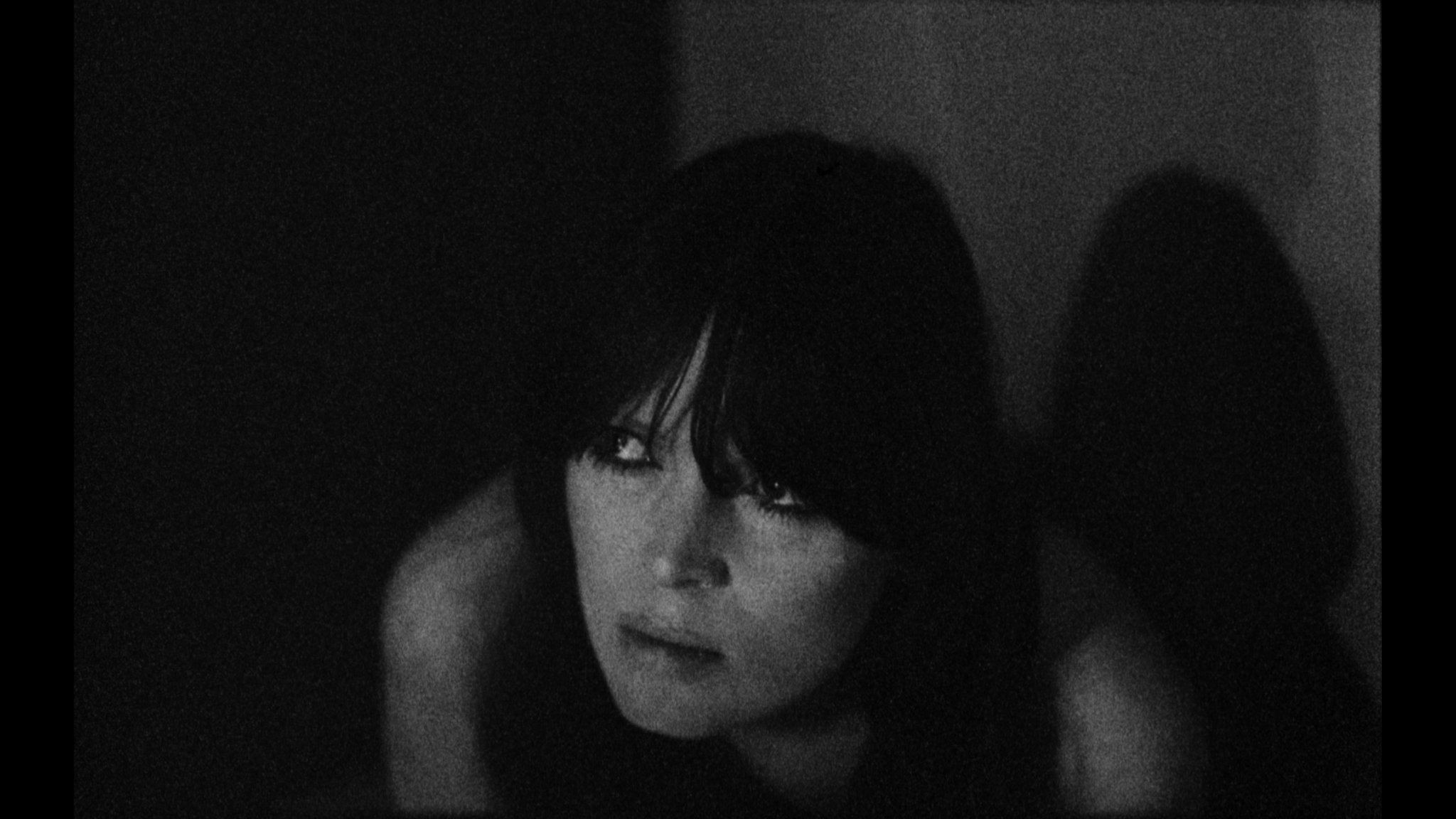Icon of the 60s and 70s, German singer, actress and model Nico was known as the priestess of darkness. In her film Solitude, Nina Danino communes with a divine, doleful image of Nico and continues her recent fascination with transcendent songs of suffering.
by Laura Staab
Les Hautes Solitudes in Solitude (Nina Danino, 2022)
In the dark times / Will there be singing? / There will be singing / Of the dark times.
– Bertolt Brecht, Svendborg Poems (1938)
72 minutes in a cinema auditorium with Nico might not be the most appealing prospect. After a cameo in Federico Fellini’s La Dolce Vita (1960) and a starring role as an aspiring dancer in a French feature called Striptease (1963), she appeared as a glamorous but lugubrious sixties starlet in Andy Warhol’s Chelsea Girls (1966), as a wailing woman in Philippe Garrel’s La Cicatrice intérieure (1972), and then in a silent state of drugged-out pauperdom in Garrel’s portraits throughout the rest of the 1970s. Kent Jones describes Nico in those portraits as ‘looking like a ghost long before her death’ (in 1988). As for the five avant-garde, gothic albums she recorded after her fifteen minutes of Warholian fame, well, these were morbid too. Lester Bangs confessed to being frightened of Nico: her sounds for him summoned spectres of old girlfriends, as well as ghoulish thoughts of the abyss. After listening to her for months while researching and writing a New Yorker article, Brian Dillon said at a recent talk that he is not sure he wants to hear another Nico song ever again. Nico was not called the priestess of darkness for nothing. I imagine, though, that Nina Danino is attracted to that divine, doleful sobriquet, and the haunting that it holds. Communing with Nico through song and image in her tenebrous and tremulous new work Solitude, the filmmaker does not turn from the icon for being both an image and a voice of the void. She sanctifies her.
Danino practiced in feminist filmmaking circles during the 1980s and the 1990s as one of a handful of women associated with the London Filmmakers’ Co-op. Interested in the possibilities of écriture féminine for film, she cited Hélène Cixous and contemplated the Ecstasy of Saint Teresa in early works such as Stabat Mater (1990) and “Now I am yours” (1992). Since the 1990s, Danino has continued to make film while working in academia – now in the Fine Art department at Goldsmiths, where she started teaching in 2000. Her later works reflect on feminine creativity and subjectivity in relation to Catholicism and the voice, as before. I Die of Sadness Crying for You (2021) is one example of her fascination with feminine cries that transform into transcendent songs of suffering – Solitude is another.
Le Berceau de Cristal in Solitude (Nina Danino, 2022).
Solitude reprises rarefied images of an isolated Nico from Warhol’s Chelsea Girls and Garrel’s Les Hautes solitudes (1974), Un Ange passe (1975) and Le Berceau de cristal (1976). At brief intervals, these images of Nico are withdrawn, replaced with a blank screen or images of the River Thames which Danino shot on black-and-white-video during the 2020-21 lockdowns. Danino is never visible as more than a silhouette at the edge of those waters. She is, however, audible across the soundtrack, reciting fragments from seven poems and covering four of Nico’s songs in full. Woven into words by Brontë, Byron, Coleridge, Keats and Tennyson – the sort of Romantic verse Nico is said to have read in an attempt to access a certain bohemianism and to experience otherworldly visions – Danino delivers powerful vocals on ‘It Was A Pleasure Then’ (1967), ‘Frozen Warnings’ (1968), ‘Janitor of Lunacy’ (1970) and ‘Saeta’ (1981), each of which was rerecorded with professional musicians. From this immense tissue of quotation and creation, two portraits are formed: one of a hallowed Nico, and one of Danino, in devoted compassion with the troubled and troubling figure.
All of this is quite far from fashionable. Solitude venerates and sympathises with a deeply difficult woman (actually, unpalatably unlikeable), without any attempt to refashion her for contemporary mainstream feminism. Repetitions – of Garrel’s and Warhol’s films, Nico’s songs, and the Romantics’ poems – are not subversive cut-ups or appropriations but faithful renditions. And with a sombre tone, the work harks back to miserable lockdowns, while most of us are immersed in a fog of forgetting. Whatever Danino’s feminist beginnings were, I cannot picture the feminist-identifying filmgoers of today jumping for joy at such a shadowy film – so in thrall to the past, so few concessions made. Is there value in this untimeliness?
Solitude (Nina Danino, 2022)
Disregard would be nothing new for Danino. Contributing in 2015 to a roundtable among women of the Co-op, she described having worked in ‘lacunae’ of the art and film worlds for decades. Set against the abstraction and iconoclasm that came to characterise the Co-op, her enshrinement of women in rapture and women in tears appeared much too emotional, personal, and representational. When the Young British Artists came to dominate galleries, she felt she had next to no chance once again: this time, too academic as well as too sincere. Danino has worked, then, ‘in an interim space’. Although this might be cause for dismay – a dearth of appreciation, a lack of funds, as many as twelve years between films – this was also beneficial for her ‘because the work remained largely unco-opted’. Solitude might be reason for sorrow; it might be a source of solace too.
Laura Mulvey and Jacqueline Rose, who wrote feminist theory contemporary to the work of women in the Co-op, both recently looked back to Marilyn Monroe as an icon who was (sometimes still is) burdened with signifying the world to us. Solitude calls on Nico to more intimate ends. Danino is concerned with expressions of ‘an inner life’ in her highly subjective films. In Solitude, she calls on Nico as an icon who is able to signify the state of being turned from the world: be it in the throes of addiction or in death, in lockdown, as a marginal artist, or – compellingly and most courageously – as a condition for creative work. How often do we dwell with these negative states that do not or cannot make an appeal to the world? Danino’s Solitude gives us valuable space to do so.
[1] Kent Jones, ‘The Films of Philippe Garrel’, Film Comment 33/3 (May-June 1997): 28.
[2] Lester Bangs, ‘Your Shadow is Scared of You: An Attempt Not to Be Frightened by Nico’ [1983] in Mainlines, Blood Feasts and Bad Taste: A Lester Bangs Reader, ed. John Northland (London: Serpents Tail, 2003).
[3] Brian Dillon in conversation with Ian Penman, Foyles Charing Cross Road, London, 4 May 2023.
[4] Nina Danino, ‘Roundtable discussion: The women of the London Filmmaker’s Co-op’ [with Jean Matthee, Ruth Novaczek, Sarah Pucill and Alia Syed, chaired by María Palacios Cruz], Moving Image Review and Art Journal 4/1-2 (December 2015).
[5] Ibid.
[6] Ibid.
[7] For Laura Mulvey, Marilyn Monroe is emblematic of the allure of the commodity and a mechanisation of the human in the twentieth century. Jacqueline Rose’s reading the Hollywood star argues was made to be a site of cathexis for post-war anguish in the United States. See Laura Mulvey, Afterimages: On Cinema, Women and Changing Times (London: Reaktion, 2021); and Jacqueline Rose, Women in Dark Times (London: Bloomsbury, 2014). Danino’s use of Nico comes closer to Marlene Dumas’s ‘Dead Marilyn’ (2008), which is discussed by Griselda Pollock in ‘The missing wit(h)ness: Monroe, fascinance and the unguarded intimacy of being dead’, Journal of Visual Art Practice 16/3 (2017): 265-296.
Solitude screens at BFI Southbank as part of Experimenta’s Nico Night on 19 July.
Laura Staab is a writer based in London, with specialisms in art cinema, experimental film, and women’s filmmaking. See linktr.ee/laurastaab for links to other recent writing.



